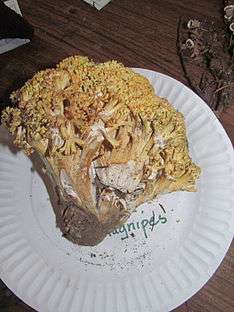Ramaria magnipes
| Ramaria magnipes | |
|---|---|
 | |
| Scientific classification | |
| Kingdom: | Fungi |
| Division: | Basidiomycota |
| Class: | Agaricomycetes |
| Order: | Gomphales |
| Family: | Gomphaceae |
| Genus: | Ramaria |
| Species: | R. magnipes |
| Binomial name | |
| Ramaria magnipes Marr & D.E.Stuntz (1974) | |
Ramaria magnipes is a coral fungus in the family Gomphaceae. It is found in western North America, where it fruits on the ground in mixed forests.
Taxonomy
The species was described as new to science in 1974 by Currie Marr and Daniel E. Stuntz in their monograph of Ramaria species of western Washington. The type collection was made near Merritt, Chelan County, Washington in 1967.[1] The variety albidior was described by Ronald H. Petersen in 1988.[2]
Description
The coral-shaped fruit bodies are relatively large, with dimensions of 9–25 cm (3.5–9.8 in) by 14–24 cm (5.5–9.4 in). The large stipe, which roots into the soil, is tapered to conical, measuring 7–14 cm (2.8–5.5 in) long by 4–6 cm (1.6–2.4 in) thick. The color of fresh fruit bodies ranges from light yellow to brownish pale orange (with white flesh), while dried specimens tend to be paler, from pale yellow to grayish orange (with pale yellow flesh). The branches are compact (giving the fruit body a cauliflower-like appearance), with about six branches from the base. The primary branches are thick, up to 3 cm (1.2 in) in diameter, while the secondary branches are usually in the range of 0.2–1 cm (0.1–0.4 in) in diameter. An edible species, its flesh has a weakly aromatic or fabaceous (bean-like) odor, and a weakly fabaceous or bitter taste.[2]
The dimensions of the spores is in the range of 10–14 by 3–4.5 µm (averaging 11.8–3.7 µm). They are cylindrical, and smooth or with very fine cyanophilous (stainable with blue dyes) warts. The basidia (spore-bearing cells) are club-shaped, two- or four-spored with sterigmata up to 14 µm long, and measure 47–80 by 8–11 µm.[1]
The variety albidior differs from the main type by having white to yellowish branches. Its spores are somewhat cylindrical to narrowly ellipsoid, and range in size from 10.8–11.9 by 3.6–4.3 µm.[2]
Ramaria obtusissima is somewhat similar in appearance. It can be distinguished from R. magnipes by its smaller size, less intense fruit body color, and its shorter spores (9.5–11.5 by 3.5–4.0 µm).[3] R. highlandensis has larger spores (with an average length of 12.4 µm), a smaller stipe, and an aromatic odor. Found in Macon County, North Carolina, it fruits in the summer.[4]
Habitat and distribution
The fungus fruits on the ground in mixed forests. It has been collected from the US states of Idaho, Washington,[1] and Tennessee. Variety albidior is found in the Sierra Nevada mountains of California, where it fruits in the spring.[2] Ramaria magnipes is a snowbank fungus, meaning it is often found around the edge of melting snowbanks, or shortly after snowmelt.[5]
References
- 1 2 3 Marr CD, Stuntz DE. (1973). "Ramaria of Western Washington". Bibliotheca Mycologica. 38. Lehre, Germany: Von J. Cramer: 105–7.
- 1 2 3 4 Petersen RH, Scates C. (1988). "Vernally fruiting taxa of Ramaria from the Pacific Northwest". Mycotaxon. 33: 101–44 (see p. 121).
- ↑ Sharda RM, Thind KS. (1986). "Genus Ramaria in the eastern Himalaya: subgenus Laeticolora–II". Proceedings: Plant Sciences. 96 (6): 519–29. doi:10.1007/BF03053546.
- ↑ Petersen RH. (1988). "Contribution towards a monograph of Ramaria. VII. New taxa and miscellany". Mycologia. 80 (2): 223–34. doi:10.2307/3807797. JSTOR 3807797.
- ↑ Arora D. (1986). Mushrooms Demystified: A Comprehensive Guide to the Fleshy Fungi. Berkeley, California: Ten Speed Press. p. 46. ISBN 0-89815-169-4.